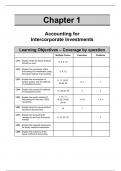Exam (elaborations)
Test Bank For Advanced Accounting, 4th Edition by Robert Halsey, Patrick Hopkins.
- Course
- Institution
Test Bank For Advanced Accounting, 4th Edition by Robert Halsey, Patrick Hopkins. ISBN: 9781618533128. Test Bank Advanced Accounting 4e Hopkins, halsey. Advanced Accounting is intended for use in undergraduate and graduate accounting programs that include a course in advanced accounting as part ...
[Show more]



